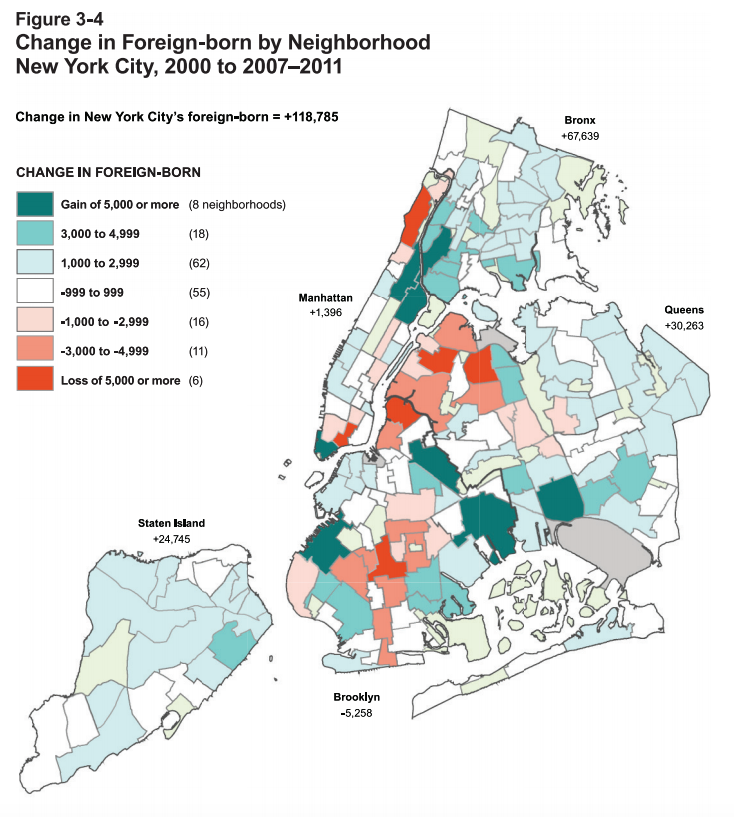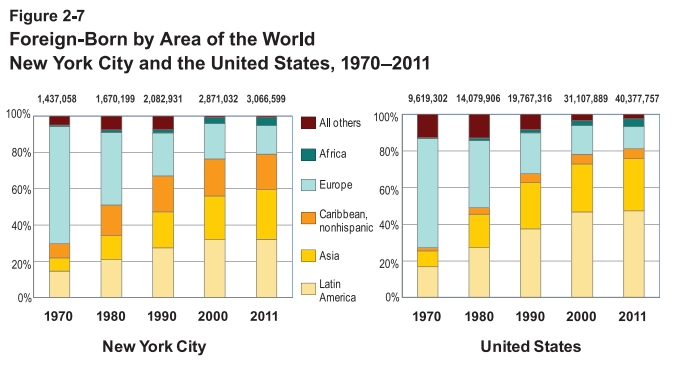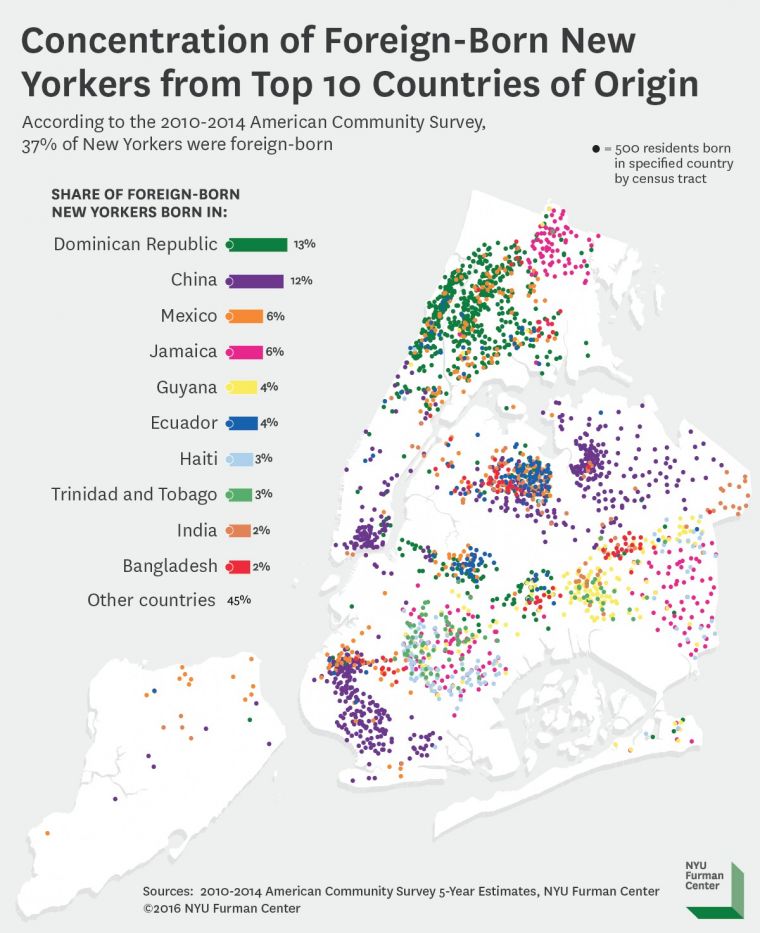Profiles in Public Service
Conversations with public servants illuminate the complex workings of city government and how local agencies shape the physical and lived experience of the city.
We are celebrating 15 years — and counting — of stories that are deeply researched and deeply felt, that build a historical record of what the city has been.
New York is the world’s most famous cosmopolis, and not in a century — despite concerns that the city has lost its role as the world’s welcome mat — have the foreign-born made up a higher share of the city’s population.
The trends buck a New Yorker’s sense of New York. During the Bloomberg years, Washington Heights lost immigrants; Harlem gained them. Jackson Heights lost immigrants; Bushwick gained them. Last year’s wisdom fades fast. The primary destination for immigrants isn’t Queens, it’s the Bronx.
As Nisha Agarwal, the commissioner of the Mayor’s Office of Immigrant Affairs, observes, all that amounts to a city where immigration structures urban life. Miami and Los Angeles may have higher percentages of foreign-born residents, but no US city can compete with New York for scale and diversity.
In the following interview, the latest in Urban Omibus’ “Profiles in Public Service” series, Agarwal explains what the Office of Immigrant Affairs does, how it interacts with the city’s various populations, and why an ID card aimed at helping undocumented immigrants includes membership to the Guggenheim. –H.G.
What’s going on with immigration in New York that would surprise people? What goes against stereotypes about where immigrants are living, what they are doing, and where they’re coming from?
I actually think the basic facts about immigrant New York are still surprising to people. I think most people who live in New York know it’s an immigrant city and has been an immigrant city for its entire history. But one out of three New Yorkers were actually born outside of the United States. Sixty percent are either immigrants or the children of immigrants. There are more immigrants in New York than there are people in Chicago. That means that in every context, every domain, people working in New York and people living in New York are interacting with immigrants and have to be thoughtful towards immigrant communities. I think that’s where an office like mine comes in. It’s different from other parts of the country.
What is your role? Does this position exist in other cities? Is it modeled after something elsewhere?
We were the first Mayor’s Office of Immigrant affairs in the country. Now there are a few. We’re basically a bridge between the city’s immigrant communities and City Hall, and our mission is very broad. It’s basically to support programs and policies that improve the wellbeing of immigrant families. That means everything from being one of the lead agencies on the municipal ID program, to working with particular sister agencies on what their priorities might be, to providing legal services. It sort of runs the gamut depending on what the needs are at the moment.
Who’s coming to New York? What are the new populations? What are the populations that used to be vibrant immigrant communities that are no longer growing so rapidly?
One great resource to answer that question is the Newest New Yorkers Report, which gives a great overview of the data on immigrants coming in and going out. But what we found is that the Chinese immigrant population is the fastest growing. It’s the second-largest immigrant population after Dominicans. But the rate of growth is so high that we’re expecting the Chinese to be the largest immigrant group soon. We’ve seen growth in the African immigrant population considerably in the last few years. And I think what we’re also seeing alongside this growth — whether it’s big groups getting bigger or newcomers to the city — is also a growing infrastructure, community organizations, and ways in which people are organizing themselves in neighborhoods, and through those organizations interacting with the city.
Do those immigrants groups reflect national policy about how many visas are issued to which countries, or is this based on something specific about New York? For example, New York already has a strong Dominican community, therefore it attracts more Dominicans because they know more people, their cousins are here, etc.
It’s a good question. I think it’s essential pull factors of New York: Economic opportunities, jobs, etc. And also there are already community members here that sort of anchor the neighborhood. New York City is easily the most diverse group of immigrant populations in the country, so we have people from all over the world that are coming. It’s different from another city like Los Angeles where a huge percentage of the population is Mexican. In New York it’s Dominicans, Chinese, Mexicans, Caribbeans – it’s really across the board.
And in terms of the skill level of immigrants who are coming here, do we have a sense of how that compares? Are they refugees with agricultural experience, or workers with high-tech skills?
I think it’s both. Most of the doctors in New York City are from outside of the United States. And then you also have lots of folks that are working at lower wage jobs who are also here. So I think it runs the gamut. One thing that New York doesn’t have a huge percentage of are refugees. We’re not a primary place of refugee resettlement in part because of the cost of living. We wouldn’t mind if that changed. We would love to welcome more refugees to New York City, but that’s one way in which we are pretty different from other cities around the country that accept and have a lot more refugees placed in their cities.
So about the cost of living: What do you hear from immigrant advocates in neighborhoods about how that can be addressed? Are people doubling up? Are they advocating for more building permits to house more people?
Immigrant communities tend to live disproportionately in overcrowded housing. And then there’s also a preponderance of immigrants living in illegal basement apartments. So there are some housing issues in which immigrants are overrepresented. But immigrants, like other New Yorkers, are concerned with housing costs and overcrowding. So we’ve seen a lot of immigrant groups involved in the larger conversation about affordable housing which has been raging across the city. But it’s also important to figure out what specific solutions are to some of these problems that I think immigrants uniquely face.
Sometime later this year, we’re having a forum with some community partners on the issue of fraud in the housing market, where you have these really shady brokers who will promise to sell an apartment to a family. They tend to take advantage of immigrants, take advantage of language barriers. And like immigration fraud practitioners, they’ll basically take somebody’s money and provide no housing in the end. It’s a big scam and it’s increasing in immigrant communities in New York. Our community partners brought that to us and said they would love for us to organize a roundtable with city agencies, law enforcement partners, and community members, so we can start to lift up what’s happening and maybe come up with some solutions. So it’s a perfect example of how we work on these things.
A municipal ID comes with a year of free membership at institutions like the Guggenheim and the Museum of Modern Art, among dozens of other institutions. What was the logic was for having all these cultural organizations included in the IDNYC project?
IDNYC is meant to be a key to accessing the wonderful things that we have in the city, and cultural institutions are obviously a big part of that. We also didn’t want to make a card just for immigrant New Yorkers. We didn’t want it to be that. We wanted it to be a symbol of being a New Yorker, not just an immigrant New Yorker, or an undocumented New Yorker. So, we thought our cultural partners are one way of making this card appealing across the board. And happily, we found that it worked. It’s not just the cultural benefits that people are drawn to. But we found that it’s one of the things that people are really excited about.
And how did you make the case to these institutions that this was a good idea to allow in 360,000 new members per year?
We started with the cultural institutions that the city is the landlord for. And they have a mission to serve New York as a broader public. The reality is most of them want to increase and diversify their audiences. So this was an option for them to be able to do that by bringing new and different people in the door. And for us it was beneficial because it gives the card a really deep utility that is different from a lot of other municipal ID card programs. So that was the conversation we had. It didn’t take a huge amount of arm-twisting or anything. I think they saw this as a way to increase their membership base but also their audience.
What proportion of card holders are immigrants?
We don’t know exactly because we don’t ask about immigration status or anything like that. But we do know that more non-English calls came to 311 in history for IDNYC than any other program. And we have a sense from our outreach staff, even when I’m in the community, that it’s hitting a lot of different immigrant communities. Corona, for example: One in five people in Corona has an IDNYC. So you have a sense that it’s getting traction in immigrant communities, but not exclusively immigrant communities.
How does ActionHealthNYC work on a community level? Especially with physical infrastructure. I imagine immigrants have a lower rate of Internet access, cell phone usage, data usage. Does this mean that reaching out to them is different since you can’t just set up some web portal and be done with it?
Immigrants are actually very mobile. Most of them have cell phones and are using phones as a way of interacting. The challenge is that, sadly, our federal policies are not very inclusive of immigrants in general, and undocumented immigrants in particular. New York State has much more flexible policies, which is fantastic. And the goal really becomes then to work on outreach to immigrants so they can understand what their options are. So that’s what our ActionHealthNYC program is. It’s very small in its initial year, but the idea is to recruit immigrants who otherwise don’t have insurance and then they can use their IDNYC card as their membership card. They get a primary care physician who is their core provider, and then depending on what their needs are, they have a care coordinator who helps them navigate health care within the system. And we’re going to evaluate the program and see what changes and what shifts it makes for immigrants who participate, and if it’s successful, maybe we’ll scale it citywide.
Can you introduce ActionNYC?
ActionNYC is a legal services program that was funded by the city. It’s structured in a couple different ways. One, with community-based hubs which have three community navigators and a lawyer. And they’re all around the five boroughs. And an immigrant could have made an appointment and come to these hubs to get legal screenings. So we say, just like you get a health screening, get a legal screening if you’re an immigrant and it gives a sense of what your options may be. Maybe you run documents and realize you may be eligible for some kind of legal relief, or maybe you want to apply for your citizenship or whatever the case may be, you have a route in through ActionNYC. In addition to those permanent hubs, we have clinics that rotate once a month to different locations around the city. We serve about 150 people per clinic, and rotational clinics serve the same idea. Come in, get your screening, and find out what you might be eligible for. And ActionNYC is set up to meet the huge legal need that exists in immigrant communities, but also potentially to get prepared for what the Supreme Court decides on the larger Obama executive action on immigration.
Is that approach a new thing? To envision getting service provision to people rather than having people come to City Hall?
Exactly. I think it’s important in thinking about the built environment. For the IDNYC, health program, and the legal services program, our goal was to actually place these services in the communities where people live. And that really makes a big difference, right? It’s places like libraries and community centers. The places where people are going, the places where they feel safe. You put these services there. It turns out people are more likely to come if you put the services there, in the places that are familiar to them.
I guess that entails a re-imagining of these communities’ facilities? Maybe a library is also a place where we can get these civic initiatives out there. It’s not just a place where you take out a book.
Exactly. I think libraries are reimagining themselves that way. Immigrant communities use libraries in huge numbers and they will ask the questions that are most sensitive to the librarian more than anyone else. Let’s take advantage of that. At the library you can just walk in, nobody will ask for your ID. You are welcome no matter who you are. That kind of openness is very appealing if you’re trying to reach immigrants.
I like that idea that the librarian is a trusted figure, confidant. Everyone trusts the librarian. All right, Nisha, thank you so much.
Of course, thank you.
This conversation has been condensed and edited for clarity.
The views expressed here are those of the authors only and do not reflect the position of The Architectural League of New York.
Conversations with public servants illuminate the complex workings of city government and how local agencies shape the physical and lived experience of the city.



